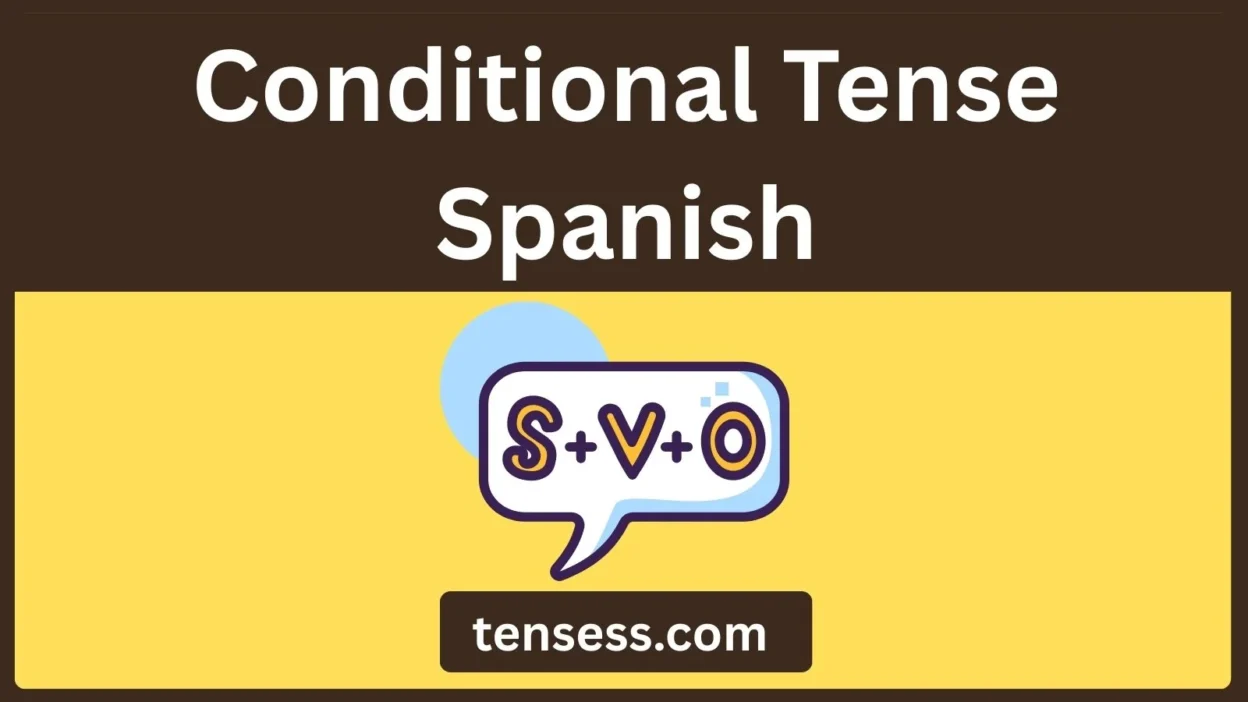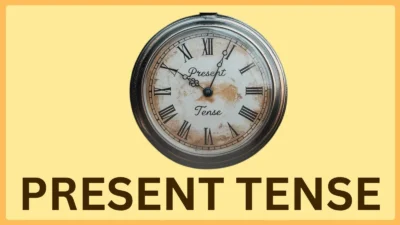Introduction
The Spanish conditional tense is a powerful tool for language learners, students, writers, and grammar enthusiasts looking to express hypothetical situations, polite requests, or future actions relative to the past.
if you’re dreaming about what you would do on a vacation or making a courteous request, the conditional tense in Spanish helps you communicate with nuance and clarity.
This beginner-friendly guide breaks down the conditional tense, its formation, and its real-life applications.
With verb conjugation tips, verb tense examples, and practice ideas, you’ll master the Spanish conditional tense in no time.
Let’s dive into how to use the conditional tense effectively and avoid common pitfalls.
What Is the Conditional Tense in Spanish?
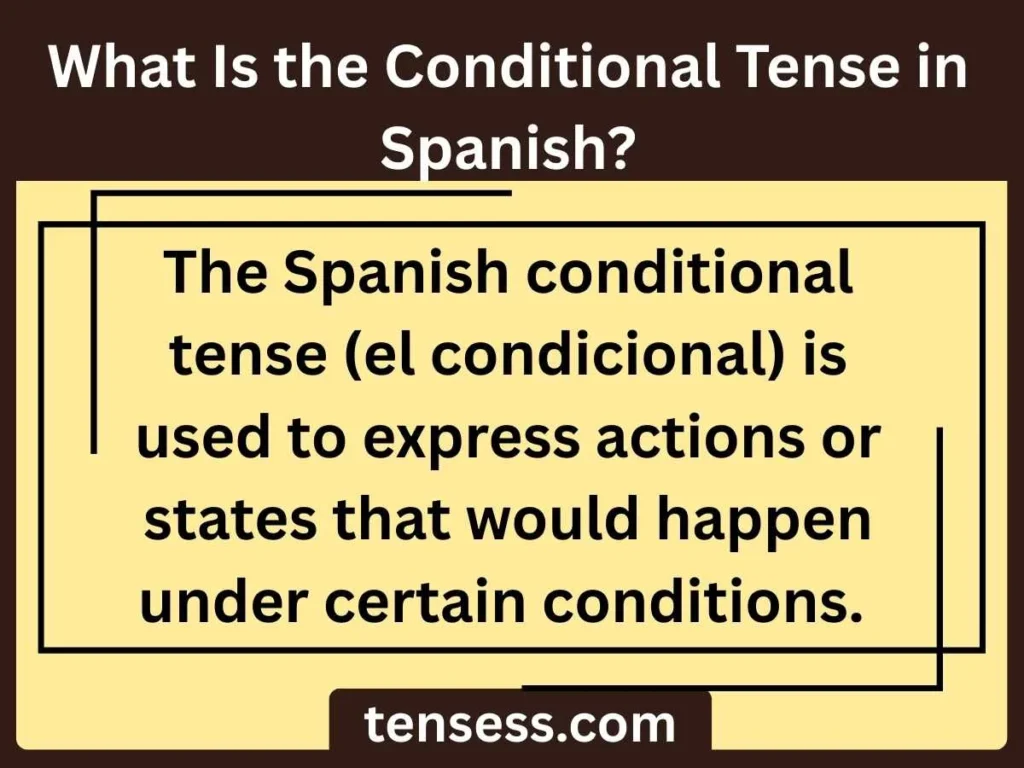
It’s often equivalent to the English “would” + verb (e.g., “I would go”). Common uses include:
- Hypothetical scenarios: “I would travel if I had money.”
- Polite requests: “Could you help me?”
- Future actions from a past perspective: “She said she would call.”
Recognition of Conditional Tense Spanish
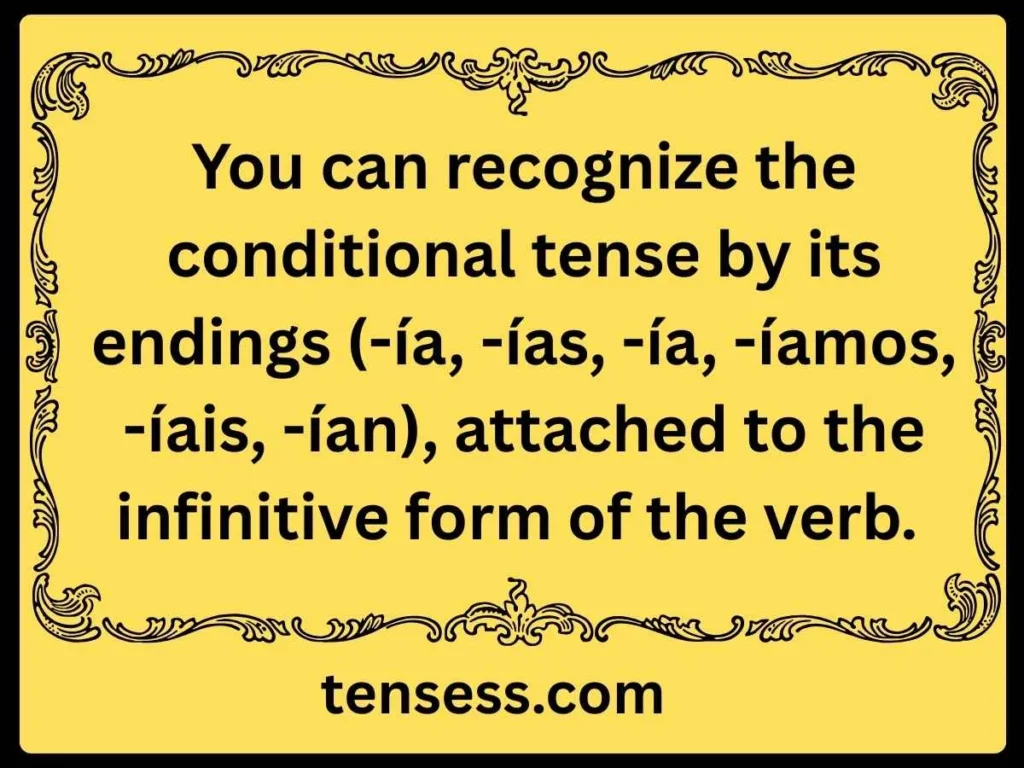
For example, hablar (to speak) becomes hablaría (I would speak).
Structure of Sentence of Conditional Tense Spanish
A conditional tense sentence typically follows this structure:
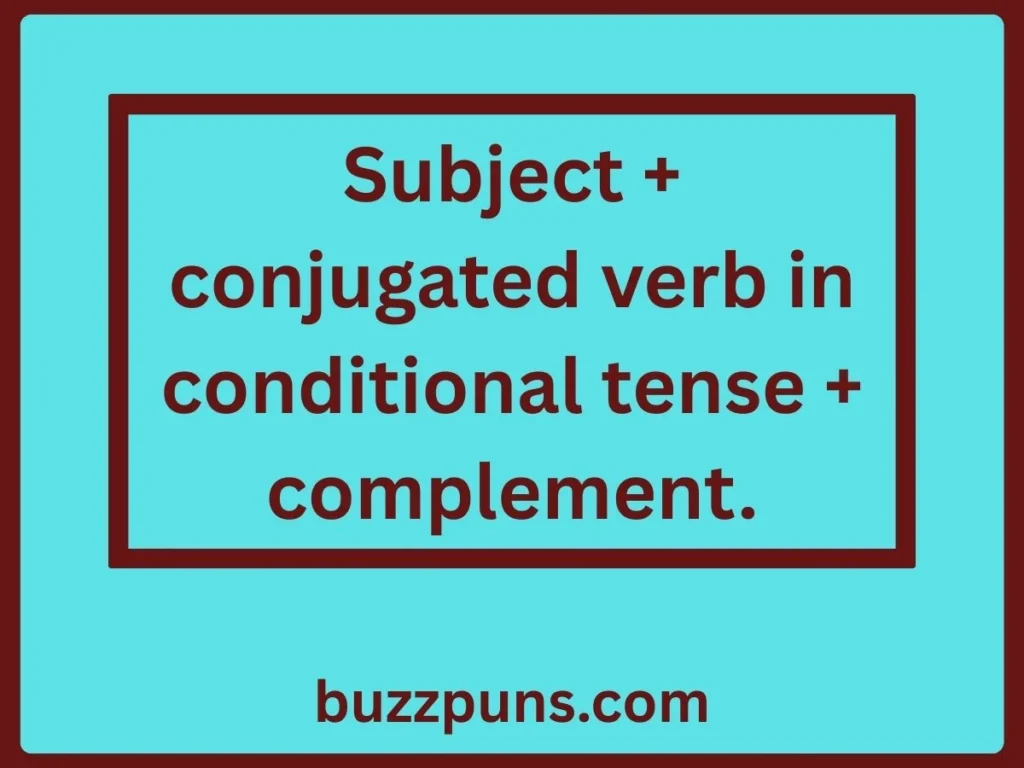
- Example: Yo comería pizza. (I would eat pizza.)
Formation of Conditional Tense Spanish
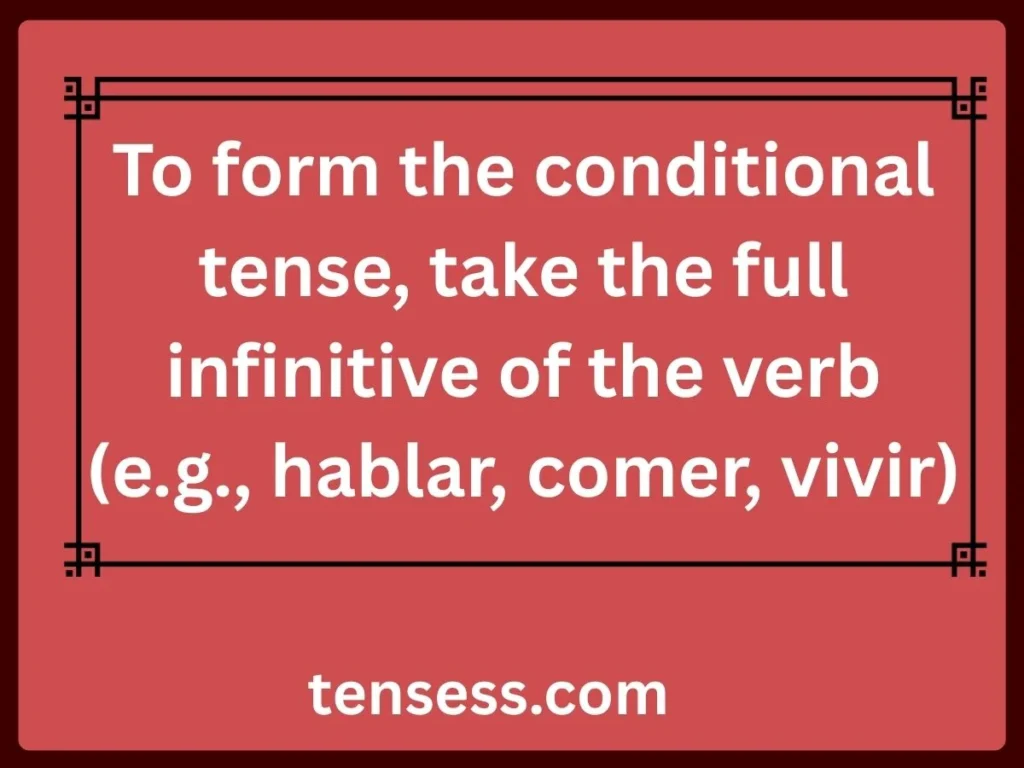
Add the appropriate endings:
- -ar, -er, -ir verbs share the same endings: -ía, -ías, -ía, -íamos, -íais, -ían.
Verbs
The conditional tense applies to both regular and irregular verbs. Regular verbs follow the standard pattern, while irregular verbs have modified stems but use the same endings.
Helping Verbs
The conditional tense doesn’t typically rely on auxiliary verbs like “haber” (except in compound tenses like the conditional perfect). It stands alone to express hypothetical actions.
Define the Verb in the Conditional Tense
Let’s use the verb leer (to read) as an example. In the conditional tense, leer becomes leería (I would read). It expresses what someone would read under certain conditions.
Regular or Irregular?
Leer is an irregular verb in the conditional tense because its stem changes from leer to le-. However, it still uses the standard conditional endings.
10 Simple Sentence Examples
- Yo leería un libro. (I would read a book.)
- Tú leerías una revista. (You would read a magazine.)
- Él leería el periódico. (He would read the newspaper.)
- Nosotros leeríamos un poema. (We would read a poem.)
- Vosotros leeríais un cuento. (You all would read a story.)
- Ellos leerían una novela. (They would read a novel.)
- Ella leería un ensayo. (She would read an essay.)
- Usted leería un artículo. (You [formal] would read an article.)
- Los niños leerían un cómic. (The kids would read a comic.)
- Mi amigo leería un blog. (My friend would read a blog.)
How to Conjugate the Conditional Tense
Conjugating the Spanish conditional tense is straightforward:
- Start with the infinitive form of the verb (e.g., hablar, comer, vivir).
- Keep the full infinitive as the stem (unlike other tenses that drop endings).
- Add the conditional endings: -ía, -ías, -ía, -íamos, -íais, -ían.
- For irregular verbs, use the modified stem (e.g., tener → tendr-).
- Ensure agreement with the subject (yo, tú, él, etc.).
- Check for spelling changes in irregular verbs.
- Use the same endings for -ar, -er, and -ir verbs.
- Practice with regular verbs first to master the pattern.
- Memorize the 12 irregular stems (see below).
- Test your conjugation with real-life sentences.
Conjugation Table for Leer
| Subject | Conjugation |
| Yo | leería |
| Tú | leerías |
| Él/Ella/Ud | leería |
| Nosotros | leeríamos |
| Vosotros | leeríais |
| Ellos/Uds | leerían |
Spelling Changes and Irregularities
Leer is irregular because its stem changes to le-. Other irregular verbs in the conditional tense include:
- Tener → tendría (I would have)
- Querer → querría (I would want)
- Saber → sabría (I would know)
- Poder → podría (I could)
- Hacer → haría (I would do)
- Decir → diría (I would say)
- Salir → saldría (I would leave)
- Venir → vendría (I would come)
- Poner → pondría (I would put)
- Valer → valdría (I would be worth)
- Caber → cabría (I would fit)
- Haber → habría (I would have)
Examples of Conditional Tense Sentences
Here are 10 varied examples of the Spanish conditional tense using different subjects and verbs:
- Yo viajaría a España si tuviera dinero. (I would travel to Spain if I had money.)
- Tú comerías más sano con tiempo. (You would eat healthier with time.)
- Ella cantaría en el coro. (She would sing in the choir.)
- Nosotros jugaríamos fútbol. (We would play soccer.)
- Vosotros estudiaríais más. (You all would study more.)
- Ellos vivirían en la playa. (They would live on the beach.)
- Él trabajaría desde casa. (He would work from home.)
- Usted compraría un coche nuevo. (You [formal] would buy a new car.)
- Los estudiantes aprenderían rápido. (The students would learn quickly.)
- Mi hermana bailaría toda la noche. (My sister would dance all night.)
- Yo tendría un perro. (I would have a dog.)
- Tú dirías la verdad. (You would tell the truth.)
- Nosotros podríamos ayudarte. (We could help you.)
- Ellos harían una fiesta. (They would throw a party.)
- Ella sabría la respuesta. (She would know the answer.)
Common Mistakes with the Conditional Tense
Here are frequent errors and how to avoid them:
- Confusing conditional with subjunctive: The conditional tense (e.g., hablaría) is not the same as the imperfect subjunctive (e.g., hablara). Use conditional for “would” statements.
- Forgetting irregular stems: Memorize the 12 irregular stems (e.g., querer → querría).
- Incorrect endings: Always use -ía, -ías, -ía, -íamos, -íais, -ían for all verbs.
- Mixing with future tense: The future tense (e.g., hablaré) is for definite plans, not hypotheticals.
- Omitting the infinitive stem: Use the full infinitive (e.g., comer → comería), not a partial stem.
- Ignoring subject agreement: Match the ending to the subject (e.g., yo hablaría, not yo hablarías).
- Overusing in non-hypothetical contexts: Reserve the conditional for “would” or polite situations.
- Misplacing accents: Ensure accents on endings (e.g., hablaría, not hablaria).
- Using auxiliary verbs incorrectly: The conditional tense doesn’t need “haber” unless forming the conditional perfect.
- Not practicing enough: Regular practice prevents mistakes.
Related Verbs and Synonyms for the Conditional Tense
The conditional tense works with many verbs, but some are commonly confused:
- Querer (to want) vs. Desear (to wish): Querría un café (I would want a coffee) vs. Desearía un café (I would wish for a coffee). Desear is more formal.
- Poder (to be able) vs. Saber (to know): Podría ayudar (I could help) vs. Sabría la respuesta (I would know the answer).
- Hacer (to do/make) vs. Realizar (to carry out): Haría una tarea (I would do a task) vs. Realizaría un proyecto (I would carry out a project).
Sentence Comparisons
- Querría un libro, pero desearía un Kindle. (I would want a book, but I would wish for a Kindle.)
- Podría correr, pero no sabría cómo ganar. (I could run, but I wouldn’t know how to win.)
- Haría una torta, pero realizaría un evento. (I would make a cake, but I would carry out an event.)
Tips to Practice Using the Conditional Tense
- Write 5 hypothetical sentences daily (e.g., “I would travel to…”).
- Practice with regular verbs first, then move to irregular verbs.
- Use flashcards to memorize irregular stems.
- Read Spanish books and highlight conditional tense verbs.
- Speak with native speakers to practice polite requests.
- Try online conjugation tools for instant feedback.
- Create a dialogue using the conditional tense.
- Watch Spanish movies and note conditional tense usage.
- Join language forums to discuss verb conjugation.
- Use apps like Duolingo for conditional tense exercises.
Frequently Asked Questions
- What’s the difference between conditional and future tense?
The conditional tense expresses hypotheticals (“would”), while the future tense expresses definite plans (“will”). - When should I use the conditional tense?
Use it for hypotheticals, polite requests, or future actions from a past perspective. - Are there irregular verbs in the conditional tense?
Yes, 12 verbs have irregular stems (e.g., tener → tendría). - Can I use the conditional tense in writing?
Yes, it’s common in formal and creative writing for hypotheticals. - How do I avoid confusing conditional with subjunctive?
The conditional tense uses “would,” while the subjunctive expresses doubt or desire. - Is the conditional tense used in all Spanish dialects?
Yes, it’s standard across Spanish-speaking regions. - Can I combine the conditional with other tenses?
Yes, in compound tenses like the conditional perfect (e.g., habría comido). - How do I practice conditional tense conjugation?
Use conjugation tables and write daily sentences. - What are common conditional tense verbs?
Querer, poder, and hacer are frequently used. - Is the conditional tense hard to learn?
It’s beginner-friendly with practice, especially with regular verbs.
Exercises
- Conjugate hablar in the conditional tense for all subjects.
- Write 5 sentences using poder in the conditional tense.
- Identify the conditional tense in a Spanish paragraph.
- Translate: “I would eat pizza” into Spanish.
- Correct this sentence: Yo comerías un helado.
- Create a dialogue with 3 conditional tense verbs.
- Conjugate tener for tú and ellos.
- Write a hypothetical sentence about travel.
- Fill in the blank: Nosotros ______ (vivir) en México.
- Practice querer in a polite request sentence.
Quizzes
- What is the conditional tense ending for “yo”?
a) -ía b) -é c) -ara
Answer: a) -ía - Which verb has an irregular stem?
a) Hablar b) Saber c) Comer
Answer: b) Saber - Translate: “She would dance.”
Answer: Ella bailaría. - What’s wrong: Tú hablaría un libro.
Answer: Incorrect verb; should be leería (read). - Conjugate hacer for nosotros.
Answer: Haríamos - True/False: The conditional tense needs “haber.”
Answer: False - Which is correct?
a) Yo podría b) Yo podera
Answer: a) podría - Write a conditional tense sentence with vivir.
Answer: Example: Yo viviría en Paris. - What’s the stem for decir?
Answer: dir- - Identify the tense: Ellos comerían.
Answer: Conditional tense
Conclusion
Mastering the Spanish conditional tense opens up new ways to express hypotheticals, make polite requests, and add nuance to your Spanish.
By understanding its formation, practicing verb conjugation, and avoiding common mistakes, you’ll gain confidence in using this versatile tense.
Whether you’re a student, language learner, or grammar enthusiast, the conditional tense is a key step in fluency.
Try writing 5 sentences today using verbs like querer, poder, or hacer in the conditional tense.
For extra practice, use a grammar checker or join a language app to refine your skills.
Start speaking and writing with the conditional tense now to take your Spanish to the next level!
